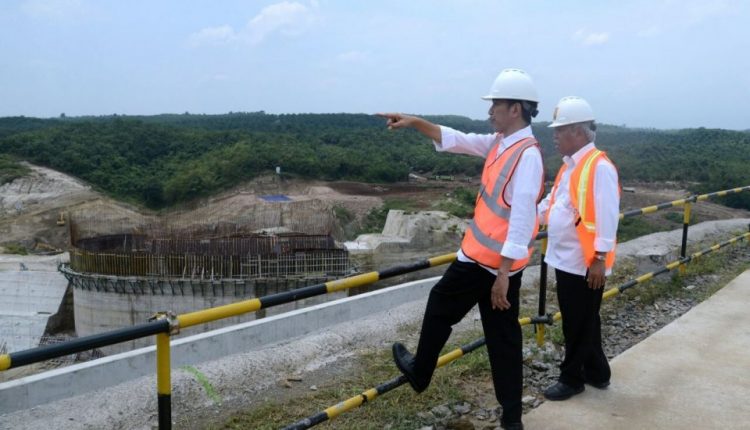Jokowi’s Aggressiveness in Handling Floods
By: Edwin Obiyandi) *
Indonesia is a country with high rainfall, so that floods can occur in various main areas in the capital city of Jakarta.
Floods that occur in the city will certainly cause greater losses because it will inundate residential areas and centers of economic activity.
The rainy season is expected to reach its peak starting in January – February 2019. According to data from the Ministry of PUPR, there are 20 flood-prone cities in Indonesia, namely Jakarta, Bandung, Surabaya, Solo, Medan, Padang, Bogor, Pekanbaru and others.
President Joko Widodo also did not remain silent in realizing this, he also helped realize his promise to deal with flood problems in DKI Jakarta through the Sukamahi and Ciawi dam projects in Bogor.
The government built two dry dams in Ciawi and Sukamahi which are part of the Jakarta flood prevention master plan. The construction of these two dams is a manifestation of Jokowi’s promise to overcome the flood problems in Jakarta, since he was still governor.
The government together with the Great Ciliwung Cisadane River Region (BBWSCC) is trying to overcome the flooding in Jakarta with the construction of the two dams, both of which will begin in 2017 and are targeted for completion in 2019. Both dams are expected to reduce Jakarta’s flooding by holding water for longer upstream.
The Ciawi Dam has a capacity to accommodate up to 6.45 million cubic meters of water or can accommodate 365 cubic meters per second. While the Sukamahi Dam has a volume of 1.68 million cubic meters or 56 cubic meters of water per second.
These two dams have the function of slowing down the speed of water to Jakarta. The water will be accommodated by the two dams first and then will be channeled to the Katulampa dam.
President Jokowi also said that the Sukamahi dam alone could reduce Jakarta’s floods by up to 30%.
Since he served as the Governor of DKI Jakarta, Jokowi has shown his sincerity in handling floods by going directly to the field, not just in meetings.
Besides that Jokowi also normalized 3 times in Jakarta. This normalization effort is done by dredging times so that times do not experience siltation. In addition, Jokowi also prepared emergency response funds of Rp 5 trillion. The funds were taken from the remaining money owned by the DKI Jakarta government in 2012. The funds were used to overcome flooding in stages, such as the construction of river infiltration and dredging wells.
Jokowi also built a retention pond in Cieunteung, Baleendah, Bandung Regency. The construction of this retention pond was then continued by building a water tunnel. According to him, this development is a solution to the annual flooding that occurred in Bandung Regency.
Not only building it, Jokowi also invited the participation of the provincial government to try to deal with the Flood. Jakarta’s potential for flooding is also difficult to contain when the rainy season is like this. According to Jokowi, the DKI Jakarta Provincial Government must immediately work and take precautions.
Jokowi asked the DKI provincial government to immediately clear the flow of rivers in Jakarta. The condition of the reservoirs in the capital also needs to be ensured. If you need to add reservoirs in Jakarta, Jokowi said.
This is because the existence of reservoirs in the capital has been proven to be effective in preventing flooding in Jakarta, and can reduce flooding for 30%.
Jokowi’s appeal to the DKI provincial government is certainly not without reason, this is because Jokowi has served as the Governor of DKI Jakarta and has taken preventive steps.
In dealing with flooding in Jakarta, it certainly cannot only rely on its upstream repairs, but it also needs to be followed by various types of repairs or normalization in the downstream region.
In taking preventive steps, Joko Widodo not only blamed but took concrete steps, revitalized the reservoir, cleansed the river and increased green open space.
This certainly shows that Jokowi is truly in the face of flooding. Where he immediately took to the field and saw firsthand what he had planned.
The strategy in dealing with floods certainly cannot be done alone, the government also needs to coordinate between ministries / institutions. In addition, socialization in potential areas at risk of flooding also needs to be encouraged by relevant agencies.
In its performance, Jokowi not only succeeded in providing preventive measures to tackle floods, but also helped to mobilize various elements to jointly strive to overcome flooding.
According to the Indonesia Research Center, Jokowi is considered the most able to solve environmental problems. In addition, Jokowi is also considered capable of facing the two most important issues in DKI, one of which is the problem of flooding.
Although the criticism flowed heavily for its performance, Jokowi was considered to have a significant ability in overcoming it. Jokowi’s direct action and descent to overcome the flood was a success. For example, the relocation of residents around the pluit reservoir turned out to be effective.
Jokowi also showed his consistency in fighting for the citizens of the capital to be free from flooding, because freeing floods in the capital is certainly not as easy as returning a palm. Freeing floods means moving people from flood-prone areas to safer places. For example by providing flats, so that people who live on the banks of the river don’t need to be afraid of their houses being flooded.
In dealing with disasters such as Floods, Jokowi is considered a human being who cannot remain silent, he is always in the place of disaster to directly observe the post-disaster situation. Jokowi’s concern in dealing with disasters certainly increases electability for people who feel the period of his leadership.
) * The author is an observer of urban planning
